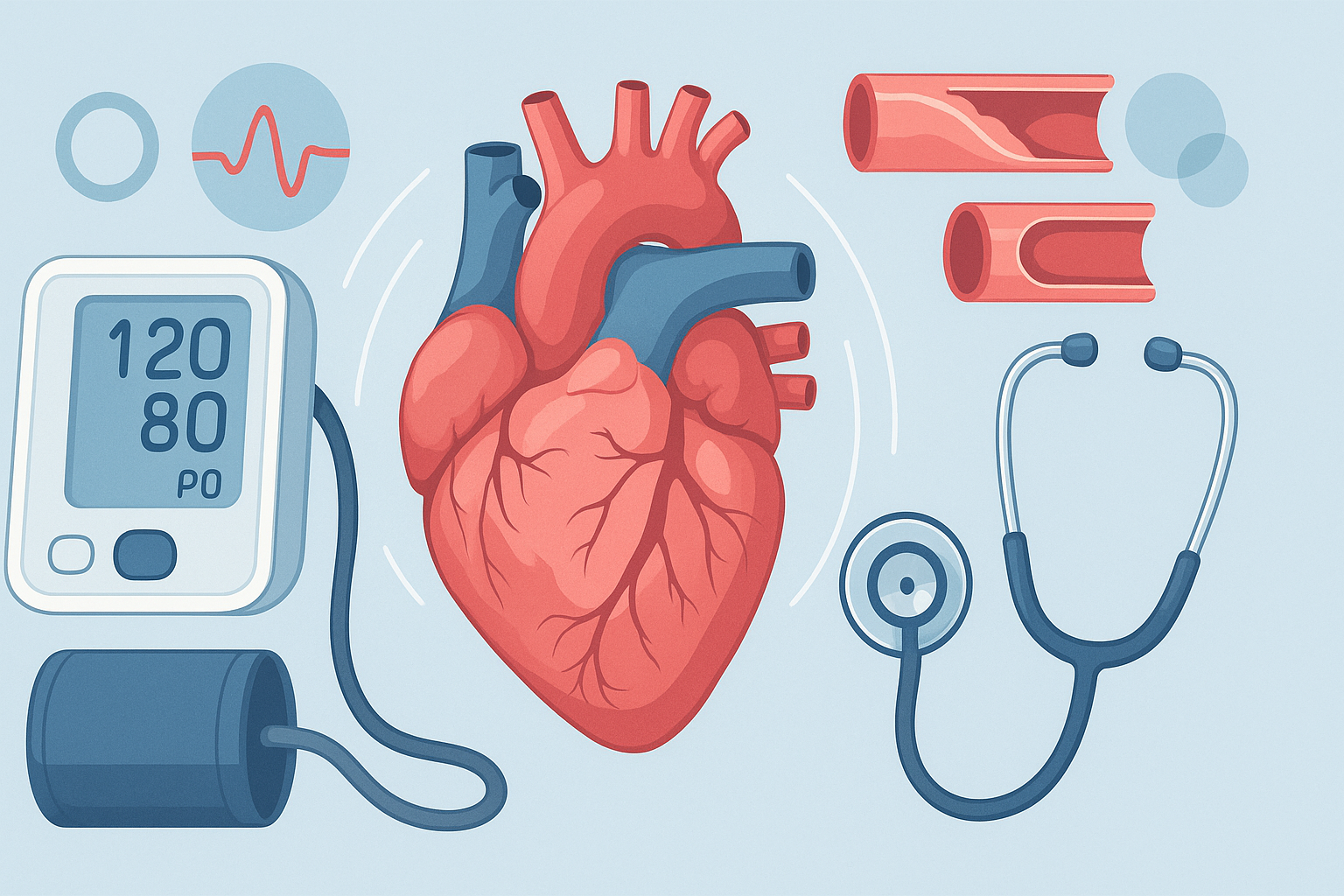Blood pressure is one of the most commonly measured indicators of cardiovascular health, yet the terminology used in medical records and conversations with healthcare providers can often seem like a language of its own. Terms like HTN, SBP, DBP, and MAP are regularly used to document cardiovascular status, but without a clear understanding of these abbreviations, patients may find themselves confused about their diagnosis and treatment. This article demystifies the blood pressure medical abbreviation system and provides a deep dive into what each term means, how it’s used in clinical practice, and why understanding these abbreviations matters for anyone managing or seeking to prevent high blood pressure.
You may also like: Sudden Spikes in Blood Pressure: What Can Cause a Sudden Increase and When to Seek Medical Attention

The Role of Abbreviations in Medical Communication
In the world of medicine, abbreviations serve an essential function. They allow healthcare providers to communicate information quickly and efficiently, especially in high-pressure settings like emergency rooms, intensive care units, and cardiology clinics. When it comes to cardiovascular disorders, where timing and precision are critical, the use of standardized abbreviations is not merely a matter of convenience—it’s a cornerstone of accurate diagnosis and effective treatment. For instance, documenting a patient’s BP as 140/90 with a diagnosis of HTN immediately signals that the individual may be experiencing stage 2 hypertension. This shared language ensures that teams across specialties and settings can interpret medical records consistently and respond appropriately.
High Blood Pressure Abbreviation: What It Means and Why It Matters
The most frequently encountered high blood pressure abbreviation in clinical settings is HTN, short for hypertension. Hypertension refers to the condition where the force of blood against the artery walls is consistently too high, often defined as a sustained blood pressure reading of 130/80 mm Hg or higher. HTN is a major risk factor for heart attack, stroke, kidney disease, and other serious health issues. In medical records, seeing a diagnosis of HTN should prompt both healthcare providers and patients to take proactive steps toward management, including lifestyle modifications and medication.
Understanding this abbreviation is crucial not only for clarity in documentation but also for fostering patient engagement. When patients recognize HTN as shorthand for a chronic but manageable condition, they are more likely to ask informed questions, adhere to prescribed treatment plans, and monitor their own blood pressure regularly. This engagement is essential, given that hypertension often presents with no obvious symptoms, earning it the moniker “the silent killer.”
Abbreviation for HTN in Clinical Context
The abbreviation for HTN appears in numerous clinical contexts, from initial patient evaluations to treatment plans and long-term health monitoring. It may be listed as a primary diagnosis on hospital discharge papers or flagged in electronic health records as a chronic condition requiring ongoing attention. In many cases, HTN is accompanied by additional abbreviations that provide a fuller picture of cardiovascular health. For example, a chart may read: “HTN, uncontrolled, with SBP persistently > 140 mm Hg despite medication compliance.”
In this sentence, SBP refers to systolic blood pressure, the top number in a blood pressure reading, which represents the pressure in the arteries when the heart beats. When HTN is labeled as “uncontrolled,” it indicates that despite therapeutic interventions, the patient’s blood pressure remains elevated, which may necessitate a reassessment of the treatment regimen. Understanding these abbreviations allows patients and their caregivers to grasp the severity of the condition and the importance of adhering to medical advice.

Blood Pressure Medical Abbreviation Breakdown
Blood pressure is typically documented using several key abbreviations, each conveying critical information. BP itself stands for blood pressure and is usually recorded as a ratio: SBP/DBP. SBP, or systolic blood pressure, indicates the pressure during heartbeats, while DBP, or diastolic blood pressure, reflects the pressure when the heart is at rest between beats. These two numbers provide a comprehensive view of cardiovascular strain.
Another vital blood pressure medical abbreviation is MAP, which stands for Mean Arterial Pressure. MAP is a calculated value that gives insight into the average pressure in a person’s arteries during one cardiac cycle. This measurement is especially useful in intensive care settings or when assessing the effectiveness of antihypertensive medications. A normal MAP is generally considered to be between 70 and 100 mm Hg. Values outside this range can signal a risk for inadequate tissue perfusion or cardiovascular complications.
Additionally, terms like HTN-C (hypertensive crisis), WCH (white coat hypertension), and MH (masked hypertension) appear frequently in specialized settings. These abbreviations help distinguish between various forms and presentations of high blood pressure, each requiring a tailored diagnostic and therapeutic approach. For instance, WCH describes a situation where a patient’s blood pressure is elevated in clinical settings but normal at home, often due to anxiety, whereas MH denotes high blood pressure at home that goes undetected in clinical environments.

Why Understanding Abbreviation Hypertension Terms Matters for Patients
For patients, understanding the abbreviation hypertension and its related terms has significant implications for personal health literacy. Health literacy—the ability to obtain, process, and understand basic health information—is strongly correlated with health outcomes. Patients who are familiar with abbreviations such as HTN, SBP, and DBP are better equipped to interpret test results, comprehend doctor’s notes, and participate actively in their own care. This can lead to better management of chronic conditions, fewer hospitalizations, and improved quality of life.
Moreover, this understanding empowers patients to communicate more effectively with healthcare providers. Rather than feeling overwhelmed or confused during appointments, informed patients can ask clarifying questions about their treatment options, medication side effects, and blood pressure goals. They can also recognize warning signs that may indicate a need for immediate medical attention, such as sudden spikes in BP or symptoms of hypertensive emergencies.

Practical Applications of Blood Pressure Abbreviations in Diagnosis and Monitoring
In daily medical practice, abbreviations related to blood pressure are used not just for documentation but also for diagnostic precision and ongoing monitoring. For example, ambulatory blood pressure monitoring (ABPM) and home blood pressure monitoring (HBPM) are two methods frequently referenced by their abbreviations. These tools help clinicians identify patterns that may not be evident during isolated office visits, particularly in cases of WCH or MH.
The abbreviation HTN may also appear in various risk stratification tools and clinical guidelines. For instance, the American College of Cardiology (ACC) and the American Heart Association (AHA) often use these abbreviations in their clinical algorithms to categorize patients and recommend appropriate treatments. A patient categorized as having “HTN, Stage 1, with DBP between 80-89 mm Hg” will receive different management strategies than someone labeled with “HTN, Stage 2, with DBP > 90 mm Hg.”
Additionally, understanding the meaning behind abbreviations helps patients and providers track progress over time. When a chart reads “HTN, improved, SBP now <130 mm Hg,” it communicates that the treatment plan is working. This type of documentation not only guides future care decisions but also serves as a motivational tool for patients striving to manage their condition.

Navigating Electronic Health Records and Medical Documentation
Electronic Health Records (EHRs) have become the standard for storing and managing patient data, and abbreviations are a central feature of these systems. Navigating EHRs often requires familiarity with commonly used shorthand, especially in specialties like cardiology or internal medicine. For instance, a cardiologist might enter a note stating: “Pt with hx of HTN, BP today 150/95, plan to titrate ACEi.” In this brief note, PT means patient, HX means history, and ACEi refers to angiotensin-converting enzyme inhibitors, a class of medications used to treat high blood pressure.
Understanding this shorthand can transform a seemingly opaque medical record into a valuable source of health information. It allows patients to track their progress, understand their care plan, and advocate for themselves more effectively. It also facilitates clearer communication between healthcare providers, ensuring continuity of care across different settings and specialists.

Improving Patient Outcomes Through Abbreviation Awareness
Patient outcomes are closely tied to their understanding of their diagnosis and treatment. By demystifying the abbreviations commonly used in blood pressure documentation, patients become more engaged and proactive in their care. This engagement often leads to better adherence to medication regimens, healthier lifestyle choices, and more effective communication with healthcare teams.
Additionally, healthcare providers benefit from patients who are knowledgeable about these terms. It reduces the time needed to explain basic concepts during consultations and allows for more meaningful discussions about treatment goals and strategies. In turn, this can improve clinical efficiency, reduce miscommunication, and enhance the overall quality of care.
Incorporating abbreviation education into patient encounters—such as through printed materials, digital resources, or during routine consultations—can yield measurable benefits. When patients understand what HTN means and how it relates to their BP readings, they are more likely to monitor their health regularly and seek timely interventions when necessary.
The Evolving Language of Cardiovascular Care
Medical language is not static; it evolves alongside advancements in research, technology, and clinical practice. As new treatments and diagnostic tools emerge, so too do new abbreviations. For example, terms like RH (resistant hypertension), ISH (isolated systolic hypertension), and IDH (isolated diastolic hypertension) reflect nuanced subtypes of HTN that have only recently gained clinical recognition.
Staying informed about these developments is vital for both healthcare professionals and patients. Continuing medical education (CME) courses for providers and public health campaigns for patients can help bridge knowledge gaps and ensure that all stakeholders are speaking the same language. In an era where precision medicine is becoming the norm, the ability to interpret and apply medical abbreviations correctly is more important than ever.
Frequently Asked Questions (FAQ): Understanding Blood Pressure Abbreviations
1. How do high blood pressure abbreviations influence medication dosing strategies?
Understanding high blood pressure abbreviations allows clinicians to streamline and tailor antihypertensive therapy in real time. For instance, a patient with a diagnosis of HTN and persistently elevated SBP may require a specific class of medication that targets systolic pressure more effectively than diastolic. When the abbreviation hypertension appears in electronic records, it can automatically prompt a review of guideline-based protocols that match current readings with pharmacologic interventions. Moreover, abbreviations like MAP (Mean Arterial Pressure) or ISH (Isolated Systolic Hypertension) help fine-tune treatment plans beyond standard blood pressure readings. Clinicians using abbreviation for HTN in charting can also leverage clinical decision support tools that auto-generate medication alerts, thereby improving precision in dosage titration and patient safety.
2. Can patients use blood pressure medical abbreviations when using home monitoring devices?
Absolutely—and they should. Many home monitoring apps and devices now allow users to input or view results using standard blood pressure medical abbreviation formats. This is particularly useful for communicating with healthcare providers, especially when sharing data through patient portals. By inputting readings alongside terms like SBP and DBP, patients create clearer and more actionable records. Furthermore, understanding high blood pressure abbreviation codes enhances one’s ability to detect patterns that may indicate changes in cardiovascular health. Patients who grasp the abbreviation hypertension terminology are also more likely to report data trends with context, allowing physicians to act earlier in the disease process.
3. Why is the abbreviation for HTN commonly used in global health initiatives?
The abbreviation for HTN is widely used in public health and global health documentation because it allows for consistency across multilingual and multicultural platforms. Whether in clinical trials conducted in sub-Saharan Africa or community screenings in Southeast Asia, using the abbreviation HTN ensures uniform understanding among health professionals. It also simplifies large-scale data aggregation for surveillance and research, making it easier to track trends in cardiovascular disease. Global initiatives such as the WHO’s HEARTS technical package use HTN-related terms to unify hypertension management protocols across nations. When used properly, high blood pressure abbreviation systems eliminate semantic barriers, ensuring continuity of care and accurate reporting worldwide.
4. How are abbreviations for hypertension used in predictive analytics and AI healthcare models?
Predictive health algorithms often rely on structured clinical data, where blood pressure medical abbreviations like HTN and SBP serve as standardized inputs. These abbreviations enable faster parsing and pattern recognition by artificial intelligence systems trained to detect early signs of cardiovascular risk. For example, an AI model might flag a patient with repeated entries of abbreviation for HTN and increasing DBP values as high-risk, prompting clinicians to intervene before complications arise. Abbreviation hypertension terminology also supports interoperability across platforms, allowing machine learning models to synthesize information from hospital systems, wearables, and national databases. The clarity and consistency offered by such abbreviations enhance both the scalability and accuracy of digital health tools.
5. What are the psychological impacts of seeing blood pressure medical abbreviations in medical records?
For some patients, encountering blood pressure medical abbreviations in their health records can feel alienating or intimidating. The shorthand can seem like a hidden language, leading to feelings of confusion or anxiety. However, with proper education, understanding these abbreviations becomes empowering. Patients who know what HTN or SBP stands for often feel more in control of their health, improving self-efficacy and engagement. Healthcare systems that integrate simple explanations of high blood pressure abbreviation terms into patient portals can reduce health-related anxiety while fostering stronger provider-patient communication.
6. Do high blood pressure abbreviations vary between specialties like nephrology and cardiology?
Yes, though the core high blood pressure abbreviation set remains the same, the context and emphasis may differ between specialties. In cardiology, abbreviation hypertension may be accompanied by additional terms like LVH (left ventricular hypertrophy) or CAD (coronary artery disease) to illustrate complications. In nephrology, HTN might be linked more closely with CKD (chronic kidney disease) or eGFR readings. These variations reflect each specialty’s unique priorities and perspectives on disease management. Nonetheless, the abbreviation for HTN remains a foundational term across disciplines, helping unify care across complex, multi-systemic cases.
7. How does familiarity with the abbreviation hypertension impact emergency care decisions?
In emergency settings, rapid interpretation of notes containing the abbreviation hypertension can be lifesaving. Clinicians encountering HTN in a patient’s chart will quickly assess for signs of hypertensive emergency, including symptoms like chest pain or neurological changes. The abbreviation serves as an immediate red flag that prioritizes diagnostic tests and fast-tracks medication delivery. When paramedics or ER staff share a common understanding of blood pressure medical abbreviation terminology, they’re better equipped to act without delay. In such time-sensitive situations, consistent use of high blood pressure abbreviation systems ensures seamless communication from pre-hospital to in-hospital care.
8. Are there any risks or drawbacks to relying too heavily on blood pressure abbreviations in healthcare?
While the use of blood pressure medical abbreviation systems enhances efficiency, it can sometimes lead to oversights or misinterpretations. For example, if HTN is documented without context, a clinician might overlook critical nuances such as whether the hypertension is controlled, resistant, or white coat in nature. Overreliance on shorthand can also contribute to communication breakdowns with patients who are unfamiliar with the terminology. That’s why it’s essential for providers to supplement these abbreviations with clear, explanatory language during consultations. Using high blood pressure abbreviation codes responsibly requires balancing clinical efficiency with patient comprehension.
9. How is the abbreviation for HTN evolving with remote and telehealth medicine?
The expansion of telehealth has given rise to new protocols that integrate the abbreviation for HTN into virtual care frameworks. For instance, remote patient monitoring devices now often sync directly with electronic health records, auto-generating entries like “HTN: BP 145/92, advised increase in ACEi.” This seamless recording helps clinicians maintain accurate timelines of disease progression and response to treatment. Additionally, telehealth teams are being trained to explain the meaning of abbreviation hypertension to patients during virtual visits, ensuring informed consent and shared decision-making. As telemedicine continues to evolve, the strategic use of blood pressure medical abbreviation terminology will play a pivotal role in delivering quality cardiovascular care from a distance.
10. What innovations are emerging to help laypeople understand blood pressure abbreviations more easily?
Technology is rapidly advancing to make medical jargon more accessible to the average person. Several mobile health apps now include built-in glossaries that define common terms like abbreviation for HTN and SBP. Some EHR platforms feature hover-over tooltips that explain high blood pressure abbreviation terms in plain language. In educational settings, patient-facing dashboards are being developed to visually map blood pressure trends while translating abbreviation hypertension codes into intuitive summaries. These innovations reflect a broader shift toward transparency and health empowerment, ensuring that understanding blood pressure medical abbreviation systems isn’t reserved for clinicians alone. With these tools, patients can confidently engage with their health data and take a more active role in their care journey.
Final Thoughts on the Importance of Understanding Blood Pressure Abbreviations
Understanding the blood pressure medical abbreviation system is more than just a matter of semantics—it’s a foundational skill for anyone invested in cardiovascular health. Abbreviations like HTN, SBP, DBP, and MAP are not arbitrary codes; they are concise representations of complex clinical realities that influence diagnosis, treatment, and outcomes. Whether you’re a patient managing chronic hypertension or a provider working to optimize cardiovascular care, fluency in this language enhances clarity, promotes informed decision-making, and supports better health outcomes.
Incorporating terms such as high blood pressure abbreviation and abbreviation hypertension into everyday discussions about cardiovascular health can demystify complex medical concepts and make them more accessible. When patients understand the abbreviation for HTN and can interpret what their healthcare provider means by terms like blood pressure medical abbreviation, they are better positioned to take control of their health. In a healthcare environment that increasingly values collaboration and patient-centered care, this shared understanding can be the key to transforming outcomes and fostering long-term wellness.
Was this article helpful? Don’t let it stop with you. Share it right now with someone who needs to see it—whether it’s a friend, a colleague, or your whole network. And if staying ahead on this topic matters to you, subscribe to this publication for the most up-to-date information. You’ll get the latest insights delivered straight to you—no searching, no missing out.
Further Reading:
What Is Hypertension (HTN)? – Definition, Symptoms & Causes
Disclaimer
The information contained in this article is provided for general informational purposes only and is not intended to serve as medical, legal, or professional advice. While MedNewsPedia strives to present accurate, up-to-date, and reliable content, no warranty or guarantee, expressed or implied, is made regarding the completeness, accuracy, or adequacy of the information provided. Readers are strongly advised to seek the guidance of a qualified healthcare provider or other relevant professionals before acting on any information contained in this article. MedNewsPedia, its authors, editors, and contributors expressly disclaim any liability for any damages, losses, or consequences arising directly or indirectly from the use, interpretation, or reliance on any information presented herein. The views and opinions expressed in this article are those of the author(s) and do not necessarily reflect the official policies or positions of MedNewsPedia.


